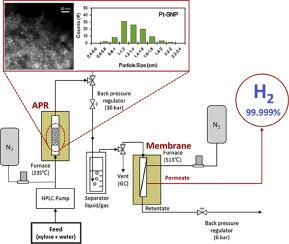International Journal of Hydrogen Energy ( IF 8.1 ) Pub Date : 2020-04-06 , DOI: 10.1016/j.ijhydene.2020.03.014 Yoondo Kim , Minkyeong Kim , Hyangsoo Jeong , Yongmin Kim , Sun Hee Choi , Hyung Chul Ham , Seung Woo Lee , Jin Young Kim , Kwang Ho Song , Chang Won Yoon , Young Suk Jo , Hyuntae Sohn

|
In this study, aqueous phase reforming (APR) of xylose was conducted over highly dispersed Pt nanoparticles supported on a γ-Al2O3 support (Pt-SNP). Formation of small Pt nanoparticles was confirmed by X-ray diffraction and transmission electron microscopy, which revealed that most of the particles ranged between 0.8 and 1.6 nm in size and the average particle size was 1.3 nm. Temperature-programmed reduction analysis indicated that these small Pt nanoparticles were highly reducible under the reducing environment compared to the commercial Pt/γ-Al2O3 catalysts (Pt-commercial). The catalytic activities of both Pt-SNP and Pt-commercial catalysts were examined in a semi-batch autoclave reactor system for the APR of xylose. It was found that Pt-SNP showed higher carbon to gas conversion with high hydrogen selectivity than Pt-commercial. This was likely due to the increased density of edge sites in the Pt-SNP catalyst that facilitated the cleavage of the C–C bonds rather than the C–O bonds, leading to greater hydrogen production. Furthermore, the Pt-SNP catalyst showed better carbon deposit resistance as compared to Pt-commercial. The amount of carbon deposition on the Pt-SNP catalyst surface and the organic carbon species dissolved in the post-reaction xylose solution were significantly lower compared to that of Pt-commercial. Finally, high purity hydrogen production was achieved using a continuous fixed-bed hybrid reactor including an aqueous phase reformer and a home-made Pd/Ta dense metallic composite membrane. A stable hydrogen gas production (99.999%) was obtained over the Pt-SNP catalyst, which demonstrated the success of a potentially commercial APR reactor system that continuously converted the aqueous xylose solution to hydrogen with high purity.
中文翻译:

通过水相在木糖上的小的Pt纳米颗粒的重整的高纯度氢产的γ-Al 2 ö 3支持
在这项研究中,水相重整的木糖(APR)中的溶液进行了超过高度分散的Pt纳米颗粒负载在γ-Al系2 ö 3载体(Pt的SNP)。通过X射线衍射和透射电子显微镜确认了小Pt纳米颗粒的形成,这表明大多数颗粒的尺寸在0.8到1.6 nm之间,平均粒径为1.3 nm。程序升温还原分析表明,这些小的Pt纳米颗粒相比于商业的Pt /还原环境下高度可还原的γ-Al 2 ö 3催化剂(铂商业)。在半间歇高压釜反应器系统中,对木糖的APR检验了Pt-SNP和Pt商业催化剂的催化活性。发现Pt-SNP显示出比Pt-商业更高的碳到气体的转化以及高的氢选择性。这可能是由于Pt-SNP催化剂中边缘位点密度的增加促进了C–C键而不是C–O键的裂解,从而导致更多的氢气产生。此外,与商业化的Pt相比,Pt-SNP催化剂表现出更好的抗碳沉积性。与Pt-商业催化剂相比,Pt-SNP催化剂表面的碳沉积量和溶解在反应后木糖溶液中的有机碳物质的含量要低得多。最后,使用包括水相重整器和自制的Pd / Ta致密金属复合膜的连续固定床混合反应器可实现高纯度氢的生产。在Pt-SNP催化剂上获得了稳定的氢气产量(99.999%),这证明了潜在的商业APR反应器系统的成功,该系统将木糖水溶液连续转化为高纯度的氢气。











































 京公网安备 11010802027423号
京公网安备 11010802027423号